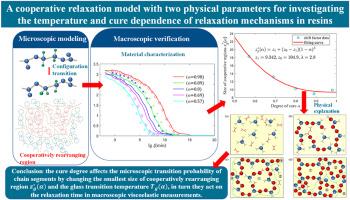A cooperative relaxation model with two physical parameters for investigating the temperature and cure dependence of relaxation mechanisms in resins
IF 3.4
3区 材料科学
Q2 MATERIALS SCIENCE, MULTIDISCIPLINARY
引用次数: 0
Abstract
Modeling the relaxation properties of resin matrix during cure plays an important role in predicting process-induced residual stresses and final distortions of resin-based composites. This paper develops a physical characterization model, which explains the temperature and cure-degree dependence of relaxation behaviors in terms of the size of cooperatively rearranging region, and special emphasis is placed on investigating the general physical mechanism of cure degree affecting the relaxation properties. In this model, the relaxation time is governed by a modified Adam-Gibbs equation, which is extended here to include the cure dependence. In addition, the relaxation modulus is modeled in a chemo-rheologically simple manner (CSM) based on the free volume theory. Material characterization is carried out using experimental data of two typical resins. It is shown that two cure-dependent model parameters, i.e., the smallest size of the cooperatively rearranging region and the glass transition temperature, are sufficient in accounting for the effect of cure on the relaxation modulus, and could provide a physical explanation of the influence of cure on relaxation behaviors. Furthermore, the proposed model is numerically realized by incorporating ABAQUS with UMAT subroutine, and its validity in predicting the residual stresses and final distortion of composites is also numerically verified by comparing with the results available in literature.

具有两个物理参数的协同松弛模型,用于研究树脂中松弛机制的温度和固化依赖性
树脂基复合材料在固化过程中的松弛特性建模对于预测工艺引起的残余应力和最终变形具有重要作用。本文建立了一个物理表征模型,从协同重排区域的大小来解释松弛行为与温度和固化度的关系,并特别强调研究固化度影响松弛特性的一般物理机制。在该模型中,弛豫时间由修正的 Adam-Gibbs 方程控制,在此对该方程进行了扩展,以包括固化依赖性。此外,还根据自由体积理论,以化学流变学简单方式(CSM)建立了松弛模量模型。利用两种典型树脂的实验数据进行了材料表征。结果表明,两个与固化有关的模型参数,即协同重排区的最小尺寸和玻璃化转变温度,足以解释固化对弛豫模量的影响,并能为固化对弛豫行为的影响提供物理解释。此外,通过将 ABAQUS 与 UMAT 子程序相结合,对所提出的模型进行了数值计算,并通过与文献中的结果进行比较,对其在预测复合材料残余应力和最终变形方面的有效性进行了数值验证。
本文章由计算机程序翻译,如有差异,请以英文原文为准。
求助全文
约1分钟内获得全文
求助全文
来源期刊

Mechanics of Materials
工程技术-材料科学:综合
CiteScore
7.60
自引率
5.10%
发文量
243
审稿时长
46 days
期刊介绍:
Mechanics of Materials is a forum for original scientific research on the flow, fracture, and general constitutive behavior of geophysical, geotechnical and technological materials, with balanced coverage of advanced technological and natural materials, with balanced coverage of theoretical, experimental, and field investigations. Of special concern are macroscopic predictions based on microscopic models, identification of microscopic structures from limited overall macroscopic data, experimental and field results that lead to fundamental understanding of the behavior of materials, and coordinated experimental and analytical investigations that culminate in theories with predictive quality.
 求助内容:
求助内容: 应助结果提醒方式:
应助结果提醒方式:


